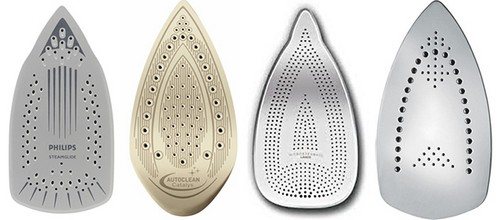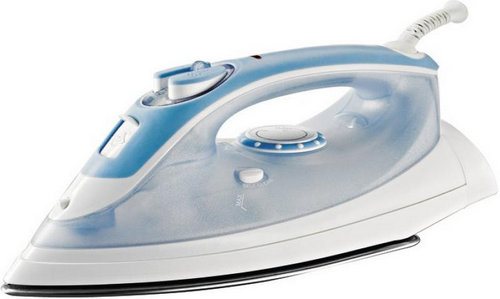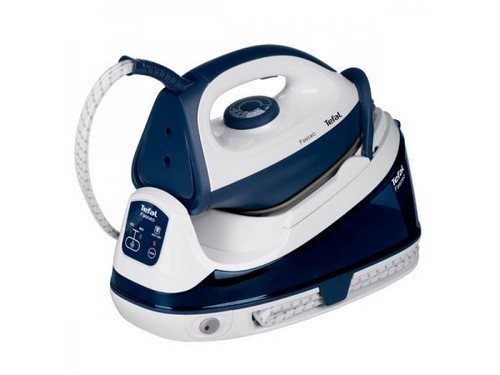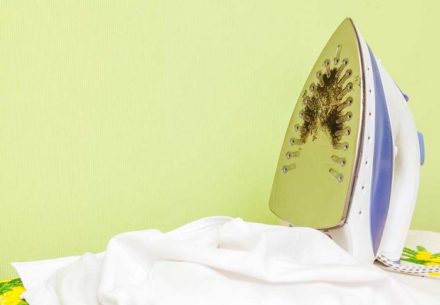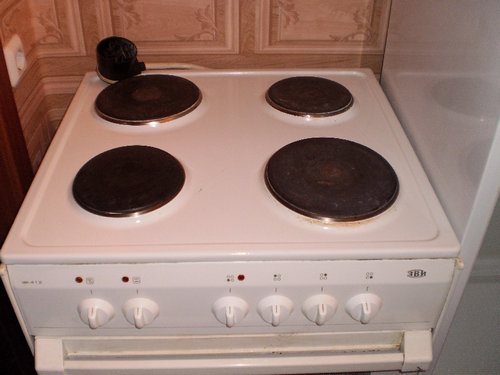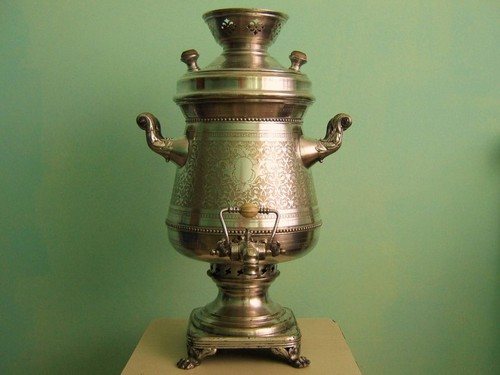When buying an iron, in the household appliances supermarket you will find special-purpose pencils for cleaning the heating surface of the iron from burning. However, many believe that there is no need for it, because a new iron is unlikely to clog. Therefore, they either postpone the purchase of this product, or “to celebrate” they buy it, with an eye on the future. Does it help, and what means exist to solve this problem.
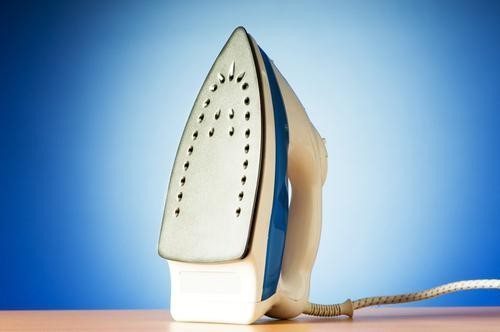
Cleaning methods at home
Burns occur due to the presence of synthetic fibers in fabrics. Today irons are equipped with thermostats, so such problems, in principle, should arise quite rarely. However, if the selected temperature does not match the type of fabric, the problem occurs more often.
Cleaning with vinegar solution
Many housewives have heard about the good cleaning ability of vinegar; it can also be used to clean the iron. During the procedure, use a gauze bandage, because vinegar emits corrosive fumes when heated. You need to add 2-3 tablespoons of vinegar per 200 ml of water. It is advisable to use high-percentage vinegar. Next, we lower a piece of fabric into the glass that can withstand high temperatures. It is clear that you will need to wipe the soleplate of the iron with a soaked cloth.
Turn on the iron and set it to medium temperature. We fold a piece of cloth in several turns and wipe the surface. The plaque should come off and remain on the fabric. To clean the depressions and steam outlets, use cotton swabs soaked in the same solution.It is advisable to carry out the "operation" in an open room for better ventilation.
You can use vinegar in a slightly different way. To do this, take a tablespoon of vinegar and pour it into the water compartment with water. Heat the iron to the highest temperature and leave it on for up to 10 minutes. During this time, the device will maintain the set temperature. After the procedure, rinse the reservoir with running water. Remove salt from the steam holes with cotton swabs or needles, pushing the blockages inside the iron, and then rinse the reservoir.
Cleaning with toothpaste
Apply the mass to the surface of the ironing surface. You can use absolutely any toothpaste. Use a brush to carefully distribute the mass over the entire burnt area. After 10 minutes, the paste can be removed with a napkin with water. The carbon deposit will remain on the napkin along with it.
Cleaning with soda
Baking soda is an excellent remedy for removing old carbon deposits. Dissolve a few tablespoons in a small amount of warm water until the consistency of sour cream. Use a sponge to collect the mass and distribute it over the affected areas; you can rub the areas a little. Teflon surfaces do not accept such procedures, since soda does not completely dissolve in water and can scratch the sole of the iron. You also cannot use toothpaste for such surfaces. Remove excess soda with a soft cloth or piece of cloth.
Using hydrogen peroxide
You can use lighter products to clean ceramic surfaces. Peroxide removes streaks or small spots on the sole. Moisten a cotton pad or just a piece of cotton wool with peroxide and wipe the affected exterior of the device.The iron should be slightly warm; it can be turned on at a low temperature, for example, at the temperature for thin fabrics, and then turned off in order to avoid burning the skin. The carbon deposits will come off the surface more easily than with a cold iron.
If peroxide is not available, you can use hydroperite in tablets. They are more concentrated, but no less effective in solving the problem. The tablets are placed on a flat surface and a hot iron is passed over them, the tablets dissolve, emit a pungent odor, and the soot lags behind the sole. You can either use a gauze bandage to avoid possible poisoning from the vapors of the tablets, or simply carry out the procedure with open windows for good ventilation in the room.
Removing burnt marks with acetone
You can moisten a cotton pad with acetone or decorative nail polish remover and wipe the affected iron platform; the burnt material will come off the sole and remain on the disc. The remaining carbon stains can be removed with the same cotton pad with acetone if you leave the iron on it for a long time, for example, overnight. The iron must be unplugged. Excess of the procedure can be removed in the morning with a clean cloth or napkin.
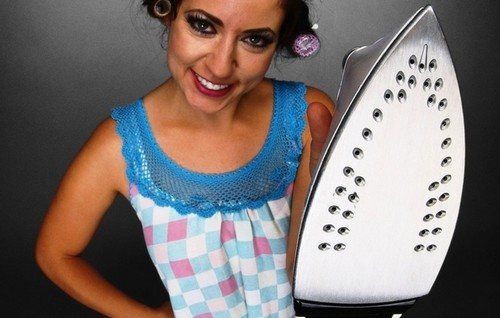
Pencil
Removing carbon deposits from synthetic fabrics is more challenging. In this case, it is advisable to use a special pencil. It cleans the surface well of carbon deposits and takes good care of it: after use, the sole becomes smoother and more slippery. This product does not leave scratches.
To use the pencil correctly, the iron is heated and placed in an inverted position. The pencil is moved over the affected areas of the surface or over its entire area.The product melts quickly, so the procedure does not take much time. Next, iron a small piece of unnecessary fabric with an iron, and apply several evaporations with the device. Clean the sole from carbon deposits.
The procedure is accompanied by a specific smell, so it is carried out either in the yard or with an open window for better ventilation of the room. Pencils, in addition, are different, so you should pay attention to the recommendations on the product packaging.
Nail polish remover
A Teflon-coated iron can be easily cleaned of synthetic materials using nail polish remover, but without acetone.
Removing carbon deposits with soap
The iron is heated and a bar of soap is passed along the soleplate. Residues of soap and carbon deposits are removed with a clean, dampened napkin or cloth. This method is good for getting rid of fresh stains. You can use a solvent; it is well suited for synthetics or polyethylene on the surface of the device. Moisten a piece of cloth with a solvent and wipe the sole of the iron with it. Remove residues with a clean cloth.

Other improvised means
- Salt can get rid of carbon deposits if the iron is not Teflon. Salt has a hard structure that can scratch or damage the surface. A sheet of paper with salt is smoothed with an iron, as a result of which all the soot remains on the salt.
- Ammonia can be an indispensable aid in the fight against burns. Moisten a napkin or cotton pad with ammonia and wipe the sole of the iron when it is turned off. Before using the iron for its intended purpose, the device must be wiped with a clean cloth.
- Sulfur will also help in cleaning burnt marks. Using a hot iron, pull a strip of sulfur over a strip of sulfur; it is found on any package of matches; any remaining burnt marks and sulfur are wiped off with a dry, clean cloth.
- Lemon juice and a couple of drops of ammonia are also effective in the fight against burning.
Causes of scorch marks and how to combat them
Scorches appear on devices without a thermostat or with a steel platform. This problem occurs less frequently on Teflon surfaces, because They have non-stick features.
The iron platform is wiped with 9% vinegar or a mixture of vinegar and 3% hydrogen peroxide. In severe cases, you can use a cloth soaked in a mixture of vinegar and hydrogen peroxide and iron it with a hot iron. The above methods are also applicable for irons with completely different sole coatings.
The method using soap is also suitable for getting rid of scorch marks on Teflon surfaces. It is safe and very simple.
The same methods for dealing with burns are also suitable for scorch marks: using soda, toothpaste or salt.
After ironing, you should empty the water from the tank to avoid salt accumulation and other problems.


